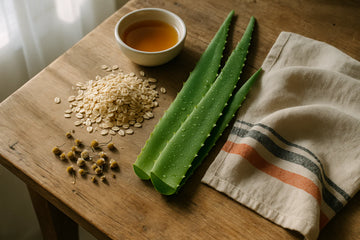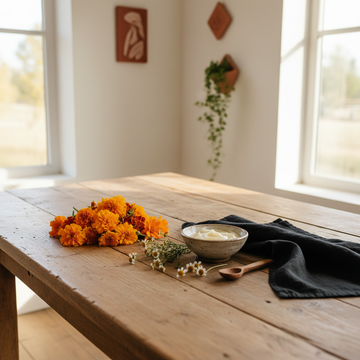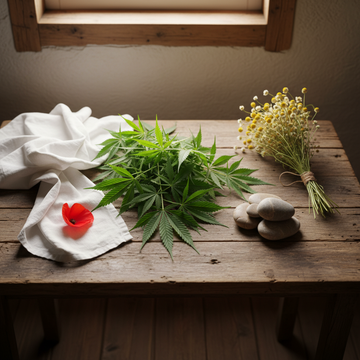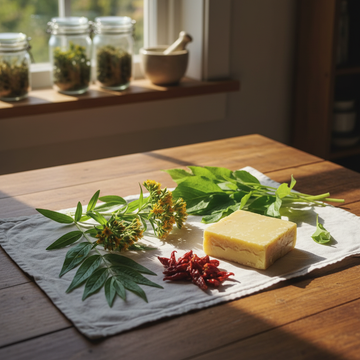When skin burns, itches, and reddens, sufferers of atopic dermatitis often desperately search for gentle relief. As the founder of H4H Naturals and through the teachings of my grandmother—a pharmacist who lived to be 102—I know how powerful natural home remedies can be for skin problems. But with atopic dermatitis, caution is advised: What helps one person can worsen another.
Key Takeaways
- This article is for informational purposes only and does not replace medical advice.
- In case of severe neurodermatitis attacks or worsening, a dermatologist should be consulted.
- Natural home remedies can be helpful for skin problems such as neurodermatitis.
- The effectiveness of home remedies can vary from person to person.
- Caution is advised, as some home remedies can worsen symptoms.
Table of Contents
- What is atopic dermatitis? – Understanding the basics
- Recognize typical symptoms and progression
- Causes & triggers: What triggers atopic dermatitis attacks?
- Home remedies for atopic dermatitis: basics and limitations
- The 5 most effective home remedies for atopic dermatitis
- Safe use: What you need to pay attention to
- Limits of home remedies: When professional help is needed
- Holistic atopic dermatitis management in everyday life
- Sustainable atopic dermatitis care: Good for the planet and skin
- Conclusion: Your path to healthier skin
In Germany, approximately 3-5% of adults and up to 13% of children are affected by atopic dermatitis. This chronic inflammatory skin disease occurs in bouts and often causes enormous suffering. Many sufferers ask themselves: What really helps with atopic dermatitis —gentle and natural?
Short answer
The most effective home remedies for atopic dermatitis are moisturizing oils such as olive oil, cooling curd wraps, anti-inflammatory chamomile compresses, and pH-regulating apple cider vinegar dilutions. Important: Always test home remedies on a small area of skin first and never use them on open wounds. They complement medical treatment, but do not replace it.
What is atopic dermatitis? – Understanding the basics
Neurodermatitis, medically known as atopic dermatitis, is a chronic inflammatory skin disease characterized by a disrupted skin barrier. "Atopic" means a genetic predisposition to allergic reactions.
Core problem: In atopic dermatitis, the skin's natural protective function is impaired. The skin barrier cannot retain moisture sufficiently and simultaneously allows more irritants and allergens to penetrate.
Course in different age groups
- Infants (0-2 years): Mostly face, scalp and extensor sides of the arms and legs affected
- Children (2-12 years): Typically in joints such as elbows and backs of knees
- Adults: Often hands, face, neck and décolleté – may appear for the first time or persist from childhood
Based on our experience at H4H Naturals, we see that adult sufferers are particularly looking for gentle, atopic dermatitis care solutions that don't impose a burden on everyday life. Here, well-thought-out home remedies can be a valuable complement to dermatological treatment.
Recognize typical symptoms and progression

The symptoms of atopic dermatitis can vary greatly and usually occur in phases. For the correct application of home remedies, it is crucial to correctly assess the current skin condition.
The main symptoms at a glance
Acute attack phase
- Severe itching, especially at night
- Redness and swelling
- Weeping blisters or crusts
- Burning or painful skin areas
Chronic phase
- Extremely dry, flaky skin
- Thickened areas of skin (lichenification)
- Cracked, partially bloody areas
- Increased susceptibility to infection
Practical tip: Document your symptoms in a skin diary. This will help you identify patterns and use appropriate home remedies for atopic dermatitis —for example, cooling applications for acute inflammation or moisturizing oils for very dry skin.
Frequently affected areas of the body
Depending on age and individual severity, neurodermatitis appears in different parts of the body:
- Face: Especially around eyes and mouth, often very sensitive
- Neck and décolleté: Common in adults, responds well to gentle care
- Joint flexion: elbows, back of knees – classic areas for children and adults
- Hands: Particularly stressful in professional life, needs intensive neurodermatitis cream or natural alternatives
Important for using home remedies: Facial skin and mucous membranes are more sensitive to home remedies. Here, you should test with particular caution and use milder concentrations.
Causes & triggers: What triggers atopic dermatitis attacks?
To use targeted home remedies for atopic dermatitis , it's important to understand what triggers atopic dermatitis flare-ups. The disease develops through a complex interplay of various factors.
Main cause: A genetically determined disruption of the skin barrier leads to increased permeability and chronic inflammatory reactions. Approximately 70% of those affected have at least one parent with atopic diseases.
The most common trigger factors
- Environmental stimuli: dry air, extreme temperatures, air pollutants
- Mechanical irritation: scratching, rough clothing, excessive washing
- Allergens: house dust mites, pollen, pet hair, certain foods
- Stress: Psychological stress increases inflammatory reactions
- Infections: Bacteria, viruses or fungi on the weakened skin barrier
- Hormonal fluctuations: Especially in women during menstruation or pregnancy
Practical experience: In our H4H community, we observe that periods of stress are often accompanied by flare-ups of atopic dermatitis. In these cases, soothing home remedies such as chamomile compresses can support not only the skin but also the sense of well-being.
Home remedies for atopic dermatitis: basics and limitations

Before we get to the specific home remedies for atopic dermatitis , it's crucial to realistically assess their possibilities and limitations. My grandmother taught me early on: "Natural doesn't automatically mean harmless."
Benefits of home remedies
- Gentle, natural ingredients without harsh chemicals
- Usually inexpensive and easily available
- Can serve as a supplement to medical treatment
- Promote the feeling of self-efficacy
- Often fewer side effects than synthetic alternatives
Disadvantages and risks
- Effect not scientifically standardized
- Allergic reactions possible
- May worsen symptoms if used incorrectly
- Do not replace professional medical treatment
- Quality and purity not always guaranteed
Important rule: Test any new home remedy first on a small, less sensitive area of skin. Wait 24 hours before applying it to a larger area.
The 5 most effective home remedies for atopic dermatitis
Based on traditional knowledge, modern studies, and the experiences of our H4H community, I present the most proven home remedies for atopic dermatitis . Each has its specific strengths and areas of application.
1. Olive oil & vegetable oils - Natural refatting
Cold-pressed olive oil is rich in vitamin E and unsaturated fatty acids, which can strengthen the damaged skin barrier. What helps with extreme dryness in atopic dermatitis ? Oils often show rapid results. Those seeking particularly intensive and natural care can also turn to an organic skin oil with jojoba, almond, and olive oil , which has been specially developed for dry and sensitive skin.
Application:
- Massage 2-3 drops onto damp skin
- As a bath additive: 1 tablespoon to a full bath
- Apply to particularly dry areas before sleeping
Alternative oils: Almond oil (very mild), coconut oil (antimicrobial), argan oil (regenerating). At H4H Naturals, we use similar principles in our certified organic formulations.
2. Quark and yogurt wraps - cooling for inflammation
The cooling and mildly anti-inflammatory effect of dairy products can provide relief during acute flare-ups. The lactic acid they contain supports the skin's natural pH balance.
- Spread natural quark or natural yoghurt (room temperature) thinly onto a clean cotton cloth
- Place the cloth with the curd side on the affected area
- Leave on for 15-20 minutes
- Rinse carefully with lukewarm water
- Gently pat skin dry and, if necessary, apply neurodermatitis cream
Caution: Do not use if you are allergic to milk protein! Use the wrap only on intact skin, not on open wounds.
3. Chamomile tea compresses - Proven anti-inflammatory
Chamomile contains chamazulene and bisabolol – active ingredients with proven anti-inflammatory and soothing effects. It has been used for centuries to treat atopic dermatitis . Those seeking additional relief can gently apply an organic body butter with hemp oil, shea butter, and jojoba oil to the affected areas after use to strengthen the skin barrier.
For chamomile compresses: Pour 250ml of boiling water over 2 teaspoons of dried chamomile flowers, let it steep for 10 minutes, strain, and let it cool. Soak a clean cloth and apply it for 10-15 minutes.
Be careful if you're allergic to daisies: About 1-2% of the population is allergic to chamomile. Be sure to test first!
4. Black tea - tannins against wetness
The tannins in black tea have an astringent effect and can dry out weeping eczema. This is particularly helpful during the acute phase.
| scope | concentration | Exposure time | frequency |
|---|---|---|---|
| Weeping spots | 2 tea bags/250ml | 10-15 minutes | 2-3 times daily |
| Itch relief | 1 tea bag/250ml | 5-10 minutes | If necessary |
| facial area | 1 tea bag/250ml | 5 minutes | 1x daily |
5. Apple cider vinegar - pH regulation
Diluted apple cider vinegar can support the skin's natural acid mantle and has antimicrobial properties. Treating atopic dermatitis naturally often results in surprisingly rapid improvement.
Proper dilution: 1 part apple cider vinegar to 10 parts water for compresses, 1:20 for sensitive facial skin. Never use undiluted!
Expert tip: Don't combine different home remedies at the same time. Test one remedy for several days before switching to another. This way, you can better assess its individual effect.
Safe use: What you need to pay attention to

Proper application determines the success or failure of home remedies for atopic dermatitis . From our experience at H4H Naturals, we know that less is often more, and patience pays off.
Golden rules for home remedies
- Always perform a 24-hour patch test before first use
- Use only on intact skin, never on open wounds
- Discontinue immediately if worsening occurs
- Home remedies complement but do not replace medical treatment
- Documentation in skin diary for better success monitoring
Special care with children and babies
Children's skin is more sensitive to home remedies. Use milder concentrations and shorter application times. For infants under 6 months of age, you should always consult a pediatrician beforehand.
Limits of home remedies: When professional help is needed
Even the best home remedies for atopic dermatitis have their limitations. As the founder of H4H Naturals, I experience daily how important it is to have realistic expectations and know when additional support is needed.
See a doctor immediately if: Severe deterioration despite treatment, signs of bacterial infection (pus, severe redness, fever), large open wounds or if home remedies trigger allergic reactions.
Modern complementary approaches
The combination of tried-and-tested home remedies and modern, scientifically based care products often produces the best results. A high-quality atopic dermatitis care cream with calendula, Manuka honey, and propolis can enhance and stabilize the effects of home remedies.
- Probiotic skin care: Supports the skin's natural microbiome
- Ceramide-rich formulations: sustainably repair the damaged skin barrier
- Hemp extracts: Soothe inflammation naturally
- Prebiotic ingredients: Promote healthy skin bacteria
My experience: The most successful treatment approaches combine traditional home remedies with modern, clean-label skincare products. This way, you get the best of both worlds—the wisdom of nature and the precision of science.
Further scientific information on the treatment of atopic dermatitis can also be found at the Allergy Information Service .
Holistic atopic dermatitis management in everyday life
Successful atopic dermatitis care goes far beyond the use of individual home remedies. Thoughtful daily management can reduce flare-ups and significantly improve quality of life.
The optimal skin care routine
Morning routine:
- Lukewarm water, max. 5 minutes shower
- Use pH-neutral, perfume-free cleaning products
- Only pat skin, do not rub
- Apply neurodermatitis ointment to slightly damp skin
- If necessary, apply home remedies such as diluted apple cider vinegar selectively
Optimize environmental factors
The right indoor air quality can be just as important as the best neurodermatitis cream . Keep the humidity between 40-60% and avoid extreme temperature fluctuations.
| factor | Optimal | To avoid | Home remedy tip |
|---|---|---|---|
| humidity | 40-60% | Below 30%, above 70% | Place bowls of water |
| Room temperature | 18-21°C | Over 24°C | Have cool compresses ready |
| Clothing | cotton, silk | Wool, synthetic | Replace fabric softener with vinegar |
| bed linen | Weekly 60°C | Rare change | Mite spray made from tea tree oil |
Stress management and relaxation
Since stress is a major trigger for atopic dermatitis flare-ups, relaxing home remedies can have a dual effect: They soothe both the skin and the mind. For particularly stressed hands, we recommend a natural hand cream with shea butter, hemp, and chamomile , which absorbs quickly and provides intensive care.
Relaxing home remedies: A warm bath with chamomile tea (not for allergy sufferers), lavender oil aromatherapy, or mindfulness exercises during skin care can reduce stress and promote skin health.
Sustainable atopic dermatitis care: Good for the planet and skin
At H4H Naturals, we firmly believe that treating atopic dermatitis naturally also means using our resources responsibly. Many home remedies are naturally sustainable—if we use them correctly.
Eco-friendly household remedy procurement
Buy home remedy ingredients like olive oil, chamomile, or apple cider vinegar in organic quality and, if possible, in reusable packaging. This not only protects the environment but also reduces the risk of pesticide residues on your sensitive skin.
- Regional procurement: Chamomile flowers from the local organic store instead of import
- Reusable containers: Use glass bottles for homemade oil blends
- Minimal Processing: Prefer cold-pressed oils
- Consider seasonality: Grow fresh aloe vera yourself in summer
Sustainability tip: Store used tea bags (chamomile, black tea) in the refrigerator—they can be reused for compresses the next day. This reduces waste and saves money.
DIY home remedies vs. certified ready-made products
While home remedies provide a wonderful starting point, certified organic products can optimize treatment. Combining both approaches— what really helps with atopic dermatitis —often yields the best long-term results. Those interested in natural and tested care will find a wide selection of certified organic skincare products specifically developed for sensitive skin and skin prone to atopic dermatitis.
Advantages of DIY home remedies
- Complete control over ingredients
- Cost-effective and available at any time
- Fresh preparation without preservatives
- Individual adaptation to skin needs
Advantages of certified products
- Scientifically tested active ingredient concentrations
- Dermatological compatibility test
- Stable, hygienic formulations
- Sustainable, fair supply chains
Conclusion: Your path to healthier skin
Treating atopic dermatitis with home remedies is a journey that requires patience, observation, and sometimes the courage to experiment. What my grandmother achieved with her simple remedies, you too can achieve—with today's knowledge and yesterday's wisdom.
The most important findings: Home remedies such as olive oil, curd compresses, chamomile tea, black tea, and diluted apple cider vinegar can be effective additions to atopic dermatitis treatment - if used correctly and safely.
Your next step
Start with a single home remedy that suits your symptoms. Keep a skin diary and monitor changes for at least two weeks. Combine proven home remedies with high-quality, certified skincare products for optimal results. Find more tips for natural atopic dermatitis treatment in our guide.
Remember: every skin is unique. What works for others may not necessarily work for you. Listen to your skin and don't be afraid to seek professional help if home remedies alone don't work.
At H4H Naturals, we understand the challenges of living with eczema. Our mission is to support you with both in-depth knowledge and carefully developed, planet-positive products. Because healthy skin and a healthy planet go hand in hand.
Frequently Asked Questions
What is neurodermatitis?
Atopic dermatitis, also known as atopic eczema, is a chronic inflammatory skin disease characterized by dry, itchy, and irritated skin. It is caused by a combination of genetic predisposition, a compromised skin barrier, and environmental factors that cause the immune system to overreact.
Which ointment helps with neurodermatitis?
An effective ointment for atopic dermatitis supports the skin barrier, provides intensive moisture, and reduces inflammation. Products with certified plant-based ingredients such as hemp extract, soothing herbal CO₂ extracts, and probiotic enzymes are particularly suitable, as they are gentle on sensitive skin and promote regeneration.
Can neurodermatitis be treated naturally?
Yes, atopic dermatitis can be effectively treated with natural methods by strengthening the skin with gentle, organic care products and soothing inflammation with herbal active ingredients. Consistent care, avoiding irritants, and a healthy lifestyle that minimizes stress and supports the immune system are important.
How long does neurodermatitis last?
The duration of atopic dermatitis varies greatly and is often chronic, with periods of acute flare-ups and periods of calm. However, with proper care and individualized treatment, the condition can be well controlled and symptoms alleviated over a long period of time.
Which home remedies for neurodermatitis?
Home remedies for atopic dermatitis focus on intensive moisture and soothing the skin, such as oatmeal compresses, which have anti-inflammatory properties, or applying cold-pressed plant oils like hemp seed oil, which strengthens the skin barrier. Avoiding hot baths and wearing breathable clothing are also simple, effective ways to provide relief.





